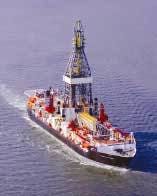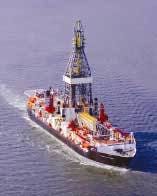Several key technologies that enable today’s deepwater drilling result from a highly classified engineering project in the early 1970s.
In July, the American Society of Mechanical Engineers named the Hughes Glomar Explorer drillship an historic mechanical engineering landmark, part of the ASME international history and heritage program.
At a public ceremony at GlobalSantaFe Corp. headquarters in Houston, several retired engineers discussed how the unique technologies they developed stretched the state of the art.
Their task was to design systems to retrieve a 2,000-ton asymmetrical object in 17,000 ft of water. Major innovations and advances in mechanical engineering include:
- Large, closable, center well opening in the hull (199-ft moon pool).
- Hydraulic heavy-lift system.
- Tapered, heavy-lift pipe string and tooljoints, with shipboard heavy-lift pipe-handling system.
- Underwater work platform, or “claw,” with mechanically articulated fingers.
- Submersible barge with a retractable cover, used to transport the “claw.”
- Pressurized seawater hydraulic system and underwater cables.
- Motion-compensated and gimbaled shipboard work platform.
- “Docking leg” system to support the weight and control “claw” motion and load during transition from open water to the moon pool.
Drillship history
This drillship has a more interesting history than most. In early 1968, a diesel-electric Soviet Golf-II submarine (K-129) sank near Hawaii in water nearly 17,000 ft deep. The location was confirmed by a US submarine, the USS Halibut. In 1969, President Richard Nixon awarded the USS Halibut the Presidential Unit Citation and later approved a Central Intelligence Agency plan to raise the 328-ft long Golf-II sub.
The US government financed the development and construction of a new ship, under the guise of Howard Hughes’s Summa Corp., with the pretext of manganese-nodule recovery in the Pacific Ocean.
Curtis Crooke, retired president of Global Marine Development Inc., recounted the Hughes Glomar Explorer history for a group of about 100 at the ASME ceremony.
Ten major corporations and many smaller ones participated in the ship’s construction and deployment: Global Marine Development Inc., Ocean Systems Div., Hughes Tool Co., Western Gear Corp., Honeywell Ocean Systems, Sun Shipbuilding & Drydock Corp., American Bureau of Shipping, General Electric Corp., Battelle Memorial Institute, and Marathon-LeTourneau.
Crooke said the ship cost about $75 million out of the Sun shipyard, but total construction costs were more than $200 million.
The Hughes Glomar Explorer was completed in July 1973. It reached the sub and made a partial recovery a year later. The overall project is estimated to have cost $350-550 million (OGJ, Nov. 17, 2003, p. 49). The Los Angeles Times broke the story in February 1975.
In 1976, the ship was mothballed at the US Navy fleet reserve center at Suisin Bay, Calif., and 20 years later, Global Marine Inc. leased and converted it into a deepwater drillship. Unfortunately, much of the unique, original equipment was removed. The ship was renamed the GSF Explorer after Global Marine and Santa Fe International merged in 2001.
Worldwide drilling
The 619-ft long GSF Explorer is now one of three dynamically positioned, ultradeepwater drillships operated by GlobalSantaFe Corp. The Explorer has been drilling in deep water worldwide.
The GSF Explorer was under repair in March-April but began a 1-year contract for BP PLC in the Gulf of Mexico, to be followed by a 2-year contract in Angola (OGJ, May 8, 2006, p. 43).
Although the ship’s construction and submarine recovery effort are often called the “Jennifer Project,” former managers speaking at the ASME ceremony insisted that name is a fabrication. Tom and Jeff Dougherty, writing for The SubCommittee Report in September 2002, claim the original codeword for the covert recovery program was Azorian (www.subcommittee.com). The truth remains classified, 36 years later.


